(Press-News.org) ROCHESTER, Minn. — In a recent Mayo Clinic study, researchers found that most patients prescribed fewer opioids after surgery were able to maintain satisfactory comfort levels without requiring more prescription refills later.
Under new evidence-based guidelines, patients undergoing various surgeries received fewer opioid pills, and 88% reported feeling "very" or "somewhat" satisfied with their pain management.
Researchers worked with the Mayo Clinic Survey Research Center to survey patients undergoing a range of elective surgeries. The survey investigated their post-surgery experiences, overall pain management approach and opioid use.
The study’s results were used to understand the connection between reducing opioid prescriptions and patient satisfaction with pain relief.
Guideline development
The guidelines were developed through research that examined the amount of opioid medication used by patients, the number of pills left over and the frequency of refills. The results were then applied to create recommendations for prescribing opioids after surgery.
"We wanted to better understand how many pills each patient needed and how many were left over, which set the foundation for publishing guidelines to say how much people need to be prescribed," says senior author of the study Cornelius A. Thiels, D.O., a surgical oncologist at Mayo Clinic.
The guidelines recommend either low, standard or high dosing for each procedure based on specific patient factors associated with variations in opioid requirements.
"We implemented these evidence-based guidelines into practice and developed educational content for pharmacists, surgeons, nurse practitioners, physician’s assistants and residents, and saw excellent compliance with the guidelines," says Dr. Thiels.
Impact on pain control
The study showed that while most patients experienced reasonable pain control with reduced opioid prescribing guidelines, a small group of patients did not find their needs met. That group may benefit from further tailoring and individualizing the opioid prescribing guidelines, the study concluded.
While the patient-focused survey supported managing pain with fewer opioids, it also underscored the need for accurate prescribing from the start. The researchers noticed that despite education efforts encouraging patients to dispose of unused opioids properly, many still had leftover pills, which could lead to misuse.
Misuse of prescription opioids remains an important contributor to the opioid epidemic in the U.S., with the study noting that in 2020 alone, 2.3 million people were reported to have a prescription opioid use disorder. That same year, over 16,000 people died from an overdose of prescription opioids.
Dr. Thiels says the findings underscore the need to balance managing pain and opioid use and the importance of educating patients and prescribing the right amount of medication in the first place.
Hallbera Gudmundsdottir, M.D., first author of the study, adds that the research "is an important first step toward not only safer but also better pain management for every patient after surgery."
Dr. Thiels and Dr. Gudmundsdottir note that future research will focus on using artificial intelligence to help achieve optimal pain control for every patient after discharge.
The Mayo Clinic Robert D. and Patricia E. Kern Center for the Science of Health Care Delivery supported this research. Review the study for a complete list of authors, disclosures and funding.
This article originally appeared on Discovery's Edge.
###
About Mayo Clinic Healthcare
Mayo Clinic Healthcare, located in London, is a wholly owned subsidiary of Mayo Clinic, a not-for-profit academic medical center. Mayo Clinic is ranked the No. 1 hospital by U.S. News & World Report for a reason: quality of care. Mayo Clinic Healthcare is the U.K.'s front door to that unparalleled experience. Visit Mayo Clinic Healthcare for more information.
END
Finding the balance: Opioids and pain control after surgery
2023-09-25
ELSE PRESS RELEASES FROM THIS DATE:
UC Irvine scientists reveal what fuels wildfires in Sierra Nevada Mountains
2023-09-25
Irvine, Calif., Sept. 25, 2023 — Wildfires in California, exacerbated by human-driven climate change, are getting more severe. To better manage them, there’s a growing need to know exactly what fuels the blazes after they ignite. In a study published in Environmental Research Letters, Earth system scientists at the University of California, Irvine report that one of the chief fuels of wildfires in California’s Sierra Nevada mountains is the decades-old remains of large trees.
“Our findings support the idea that large-diameter fuel build-up is ...
US Department of Energy Office of Science awards $115M for High Rigidity Spectrometer project at FRIB
2023-09-25
Images
EAST LANSING, Mich. – The U.S. Department of Energy Office of Science, or DOE-SC, has awarded $115 million for the High Rigidity Spectrometer, or HRS, project at the Facility for Rare Isotope Beams, or FRIB, at Michigan State University.
The HRS instrument will enable scientists to characterize the properties of isotopes that are created in rare-isotope reactions produced at about 50% of the speed of light. With the ability to measure properties such as the mass, charge and velocity of rare isotopes produced in those conditions, HRS will be a centerpiece experimental instrument ...
Algorithm would predict disease relapses
2023-09-25
A University of Texas at Arlington research team has received a $450,000 grant from the National Institute of General Medical Sciences to use statistical machine learning to review patient data and better predict which patients will need additional treatments.
“With recent advances in screening, diagnosis and treatment, many diseases like cancer or cardiovascular disease can be identified in an early stage,” said Suvra Pal, associate professor of statistics in the Department of Mathematics. “Fortunately, a significant proportion of patients living ...
Exercise-mimicking drug sheds weight, boosts muscle activity in mice
2023-09-25
A brand-new kind of drug, tested in mice, shows promising new results that could lead to the development of a new weight-loss drug that mimics exercise.
The new compound, developed and tested by a University of Florida professor of pharmacy and his colleagues, leads obese mice to lose weight by convincing the body’s muscles that they are exercising more than they really are, boosting the animals’ metabolism.
It also increases endurance, helping mice run nearly 50% further than they could before. All without the mice lifting ...
Did life exist on Mars? Other planets? With AI's help, we may know soon
2023-09-25
Scientists have discovered a simple and reliable test for signs of past or present life on other planets – “the holy grail of astrobiology.”
In the journal Proceedings of the National Academy of Sciences, a seven-member team, funded by the John Templeton Foundation and led by Jim Cleaves and Robert Hazen of the Carnegie Institution for Science, reports that, with 90% accuracy, their artificial intelligence-based method distinguished modern and ancient biological samples from those of abiotic origin.
“This routine analytical method has the potential to revolutionize ...
Wind energy projects in North America are more likely to be opposed by white, wealthy communities
2023-09-25
(Santa Barbara, Calif.) — Wind energy is, by far, the most common type of clean energy. And transitioning to clean energy is critical to addressing the climate crisis. Yet local opposition poses a significant barrier to the deployment of wind energy projects.
A study published in Proceedings of the National Academy of Sciences (PNAS) by researchers from UC Santa Barbara, the University of Michigan and Gallup Inc. examined wind energy projects throughout the United States and Canada to determine how common opposition is and what factors predict it. The study found that nearly one in five projects faced opposition ...
Naming and shaming can be effective to get countries to act on climate
2023-09-25
Enforcement is one of the biggest challenges to international cooperation on mitigating climate change in the Paris Agreement. The agreement has no formal enforcement mechanism; instead, it is designed to be transparent so countries that fail to meet their obligations will be named and thus shamed into changing behavior. A new study from the University of California San Diego's School of Global Policy and Strategy shows that this naming-and-shaming mechanism can be an effective incentive for many countries to uphold their pledges ...
Scientists develop method of identifying life on other worlds
2023-09-25
Humankind is looking for life on other planets, but how will we recognise it when we see it? Now a group of US scientists have developed an artificial-intelligence-based system which gives 90% accuracy in discovering signs of life.
The work was presented to scientists for the first time at the Goldschmidt Geochemistry Conference in Lyon on Friday 14th July, where it received a positive reception from others working in the field. The details have now been published in the peer-reviewed journal PNAS (see notes for details).
Lead researcher Professor Robert Hazen, of the Carnegie Institution’s Geophysical ...
Caribbean parrots thought to be endemic are actually relicts of millennial-scale extinction
2023-09-25
In a new study published in PNAS, researchers have extracted the first ancient DNA from Caribbean parrots, which they compared with genetic sequences from modern birds. Working with fossils and archaeological specimens, they showed that two species thought to be endemic to particular islands were once more widespread and diverse. The results help explain how parrots rapidly became the world’s most endangered group of birds, with 28% of all species considered to be threatened. This is especially true for parrots that inhabit islands.
On ...
CSIC contributes to deciphering the enigmatic global distribution of fairy circles
2023-09-25
One of the most impressive and mysterious natural formations that we can observe in the arid areas of our planet are the fairy circles. These are enigmatic circular patterns of bare soil surrounded by plants generating rings of vegetation, which until now had only been described in Namibia and Australia. Over the years, multiple hypotheses have been proposed to explain their formation, which have given rise to numerous discussions about the mechanisms that give rise to them. However, until now, we did not know the global dimension of this type of phenomena and the environmental ...





